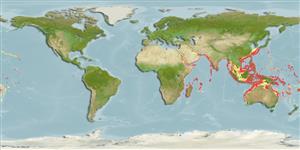>
Eupercaria/misc (Various families in series Eupercaria) >
Lutjanidae (Snappers) > Etelinae
Etymology: Pristipomoides: Greek, pristis = saw + Greek, poma, -atos = cover, operculum + Greek, oides = similar to (Ref. 45335).
More on author: Day.
Issue
Date 1871 Eschmeyer, pers. comm.
Environment: milieu / climate zone / depth range / distribution range
Sinh thái học
Biển gần đáy; Mức độ sâu 40 - 350 m (Ref. 9821), usually 125 - 275 m (Ref. 82366). Tropical; 32°N - 36°S, 33°E - 157°W
Indo-Pacific: East Africa and Red Sea to Samoa, and southern Japan southward to Australia.
Length at first maturity / Bộ gần gũi / Khối lượng (Trọng lượng) / Age
Maturity: Lm 41.7, range 35 - 50 cm
Max length : 90.0 cm TL con đực/không giới tính; (Ref. 5484); common length : 70.0 cm TL con đực/không giới tính; (Ref. 5450); Tuổi cực đại được báo cáo: 30 các năm (Ref. 46116)
Các tia vây lưng cứng (tổng cộng) : 10; Các vây lưng mềm (tổng cộng) : 11; Tia cứng vây hậu môn: 3; Tia mềm vây hậu môn: 8. Interorbital space flat. Lower jaw slightly protruding. Bases of dorsal and anal fin without scales, their last soft rays extended into shorts filaments. Pectoral fins long, reaching level of anus. Scale rows on back parallel to lateral line. Side of snout and cheek with 2 golden stripes bordered with blue. Top of head with a series of chevron-shaped yellow bands.
Gold band snappers are deepwater fish inhabiting tropical and sub-tropical waters. They are schooling fish and live in areas of hard, rocky and uneven sea floor and steep off islands (Ref. 27354). They feed on fishes, shrimps, crabs, lobsters, stomatopods, squids, gastropods and urochordates. Marketed fresh. An excellent food fish. Maximum depth from Ref. 082366.
Studies in the South China Sea (Ref. 28116) and Hawaii (Ref. 28117) suggest that this species is a serial spawner (Ref. 28115). Similar studies in Australia suggest that this species is a multiple spawner, perhaps a serial spawner (Ref. 6390).
Allen, G.R., 1985. FAO Species Catalogue. Vol. 6. Snappers of the world. An annotated and illustrated catalogue of lutjanid species known to date. FAO Fish. Synop. 125(6):208 p. Rome: FAO. (Ref. 55)
IUCN Red List Status (Ref. 130435: Version 2024-2)
Threat to humans
Harmless
Human uses
Các nghề cá: Tính thương mại
Các công cụ
Special reports
Download XML
Các nguồn internet
Estimates based on models
Preferred temperature (Ref.
123201): 12.3 - 23, mean 17 °C (based on 372 cells).
Phylogenetic diversity index (Ref.
82804): PD
50 = 0.5005 [Uniqueness, from 0.5 = low to 2.0 = high].
Bayesian length-weight: a=0.01698 (0.01015 - 0.02841), b=2.95 (2.81 - 3.09), in cm total length, based on LWR estimates for this species & Genus-body shape (Ref.
93245).
Mức dinh dưỡng (Ref.
69278): 3.8 ±0.58 se; based on food items.
Thích nghi nhanh (Ref.
120179): Trung bình, thời gian nhân đôi của chủng quần tối thiểu là 1.4 - 4.4 năm (K=0.22-0.28; tmax=14; Fec=296,000).
Prior r = 0.67, 95% CL = 0.44 - 1.01, Based on 1 data-limited stock assessment.
Fishing Vulnerability (Ref.
59153): Moderate vulnerability (43 of 100).
Climate Vulnerability (Ref.
125649): High to very high vulnerability (75 of 100).
Nutrients (Ref.
124155): Calcium = 71.6 [28.0, 146.4] mg/100g; Iron = 0.886 [0.467, 1.509] mg/100g; Protein = 18.3 [16.5, 19.9] %; Omega3 = 0.247 [0.147, 0.429] g/100g; Selenium = 90.7 [50.6, 173.7] μg/100g; VitaminA = 14.3 [4.8, 44.4] μg/100g; Zinc = 0.823 [0.551, 1.196] mg/100g (wet weight);
